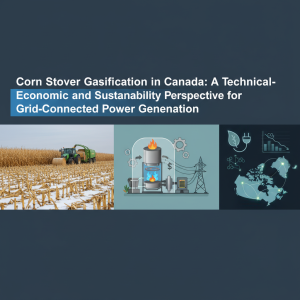Corn Stover Gasification in Canada: A Technical-Economic and Sustainability Perspective for Grid-Connected Power Generation
Introduction
The dual pressures of reducing greenhouse gas emissions while meeting growing energy demand have highlighted the potential of biomass utilization. One particularly promising agricultural residue is corn stover — the stems, leaves, cobs, and other plant residues remaining after grain harvest. This article presents a technical overview and engineering calculations for a corn stover gasification unit planned for operation in Canada, including feedstock availability, energy calculations, system efficiency, logistical considerations, and environmental impacts. Data and recent literature are referenced for each key point.
1) Why Corn Stover? Energy Content and Availability
- Lower heating value (LHV) of dry corn stover is typically 16.4–17.7 MJ/kg (depending on plant part).
- Residue yield per hectare ranges from ~6–9 dry tons/ha in temperate Canadian regions. Regional estimates suggest millions of tons/year of sustainable residues could be collected.
Technical insight: With an LHV around 17 MJ/kg and sufficient local availability (Ontario, Quebec), corn stover is a viable feedstock for small-to-medium scale renewable energy projects, provided collection logistics and soil sustainability are managed.
2) Gasification Technology — A Brief Technical Overview
Gasification is a thermochemical process converting biomass into syngas (CO, H₂, CO₂, CH₄, and inert gases) in the presence of controlled oxygen or steam. The choice of gasifier type (downdraft, updraft, fluidized bed, etc.) depends on feedstock characteristics, moisture, ash content, and end-use goals (electricity, chemical feedstock, etc.).
Syngas can generate electricity via:
- Internal combustion engines (ICE) running on cleaned syngas
- Small gas turbines or hybrid systems (including SOFCs or ORC)
Efficiency and cost depend heavily on syngas cleanup, moisture management, and the conversion technology.
3) System Efficiency and Performance
- Typical small-scale gasification → minimal syngas cleanup → ICE yields 20–35% electric efficiency.
- Advanced hybrid systems or combined heat and power (CHP) configurations can reach 40–60% efficiency in optimal conditions.
4) Sample Calculation: Feedstock Requirement for 1 MW Continuous Power
Assumptions:
- LHV of corn stover: 17.4 MJ/kg
- Electric conversion efficiency: 25%
- Operating hours/year: 8,760 h
Calculations:
- Energy required per 1 MWh: 1 MWh = 3.6 GJ = 3,600 MJ
- Required fuel energy (considering 25% efficiency): 3,600 / 0.25 = 14,400 MJ
- Mass of dry stover needed: 14,400 / 17.4 ≈ 827.6 kg ≈ 0.828 t per MWh
- Annual requirement for 1 MW continuous operation: 0.828 t × 8,760 MWh ≈ 7,250 t/year
Insight: A 1 MW continuous plant requires several thousand tons of feedstock per year; sustainable supply and logistics planning are critical.
5) Logistical Considerations
- Moisture management: Harvested stover is often high in moisture; drying or storage is required to maintain energy density and reduce conversion losses.
- Bulk density & transport: Transport in bales or chopped form affects cost; low-density feedstock increases logistics costs.
- Ash & silica content: Different plant parts vary in silica and ash, affecting gasifier operation and maintenance.
6) Environmental Impact and Carbon Emissions
- Lifecycle assessments indicate that biomass-based electricity emits significantly less CO₂ per MWh than coal (~2,257 lb CO₂/MWh) or natural gas (~976 lb CO₂/MWh).
- Properly managed corn stover harvesting can approach carbon neutrality, but must consider soil carbon, ash disposal, and energy for logistics.
- Short-term emissions from burning biomass can be substantial; careful life-cycle modeling is necessary.
7) Startup-Focused Design and Business Model for Canada
- Suggested approach: 1–5 MW centralized plant in high-corn regions (southern Ontario, parts of Quebec or Saskatchewan).
- Baseline technical architecture:
- Feedstock reception, sorting, pre-processing (chopping/pelleting)
- Drying and controlled storage
- Gasifier (fluidized bed or downdraft) with syngas cleanup
- Power generation: piston engine or microturbine
- Optional heat recovery (CHP)
- Preliminary economic model must include feedstock cost ($/t), CapEx, O&M, electricity revenue, and any carbon or renewable energy credits.
8) Risks and Research Needs
- Sustainable feedstock supply: Excessive removal can degrade soil carbon.
- Local feedstock testing: LHV and ash content must be verified for local Canadian stover.
- Syngas quality and engine wear: Impurities (tars, particulates) require adequate cleanup; underestimating this reduces system lifetime.
9) Executive Summary / Key Takeaways
- Corn stover is a promising feedstock with 16.5–17.5 MJ/kg LHV for small-to-medium scale gasification projects.
- For a 1 MW continuous plant at 25% efficiency, annual feedstock need ≈ 7,250 t/year.
- Electric efficiency ranges from 20–35% in typical systems; advanced systems can reach 40%+.
- Prior to deployment, detailed lifecycle assessment, sustainability planning, and logistics analysis are required.
References / Suggested Reading
- Experimental studies on corn stover energy content and ash properties.
- Reviews on electricity generation from biomass gasification and hybrid systems.
- Statistics Canada / Agriculture Canada — corn production and residue availability.
- Lifecycle assessments comparing biomass vs fossil fuels.
